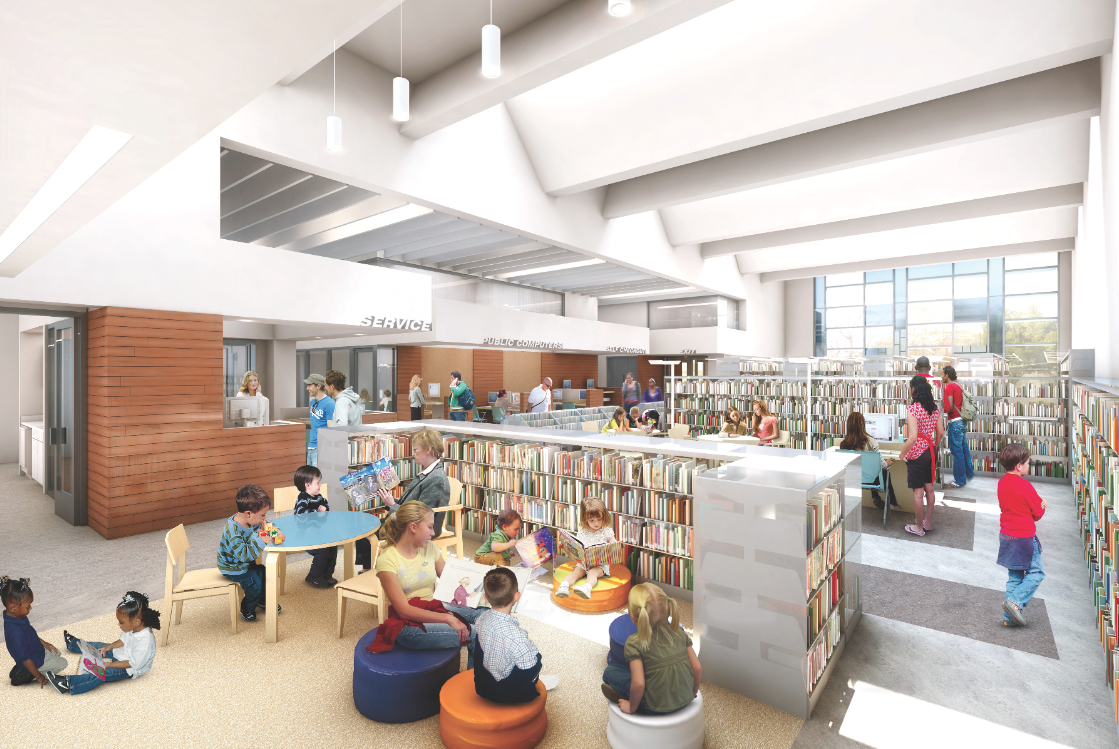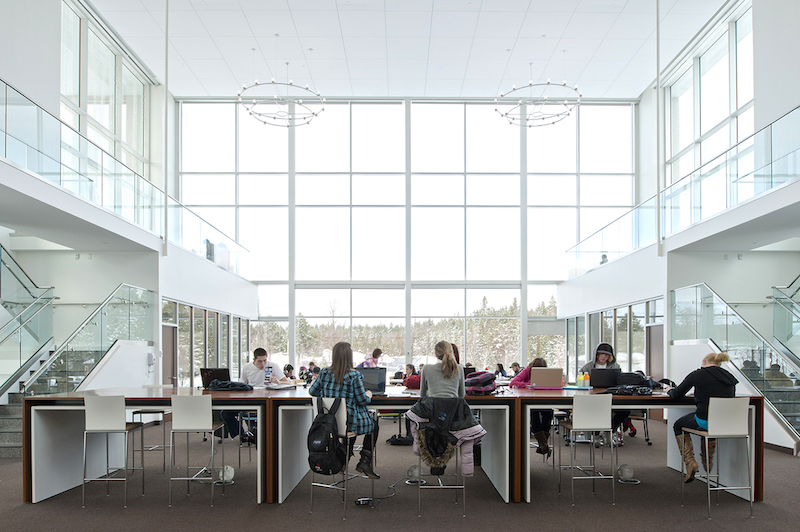Situated on a tiny, quarter-acre lot along bustling University Avenue, Berkeley, Calif.’s, new West Branch library may not be large in stature, but it’s one of the most significant library projects of the year.
Due to open in August, the 9,500-sf facility will join a handful of libraries across the country that are net-zero energy performers. And, if all goes as planned, the facility will achieve net-positive energy performance—supplying power back to the city’s electrical grid—and have a carbon-neutral footprint.
The project’s Building Team, led by Harley Ellis Devereaux’s GreenWorks Studio (www.harleyellisdevereaux.com), is targeting LEED Platinum. The $5.5 million library is one of the first projects to take part in the California Public Utility Commission’s ZNE Energy Pilot Program, supported by the Pacific Gas and Electric Co.
Michael Bulander, LEED AP BD+C, Associate with Harley Ellis Devereaux, says the PG&E partnership was critical to achieving NZE performance on the West Branch project. The utility subsidized early computer modeling work, including computational fluid dynamics analysis of ventilation schemes and a solar axis study for the rooftop solar installations.
The latter was especially tricky, says Bulander, due to the project’s tight urban site. “The starting point for the entire design was actually the building’s roof,” he says. “Because taller buildings surround the tiny site—including a three-story hotel next door—the team had to determine the optimal roof configuration for accommodating as many PV and solar thermal panels as possible, and for minimizing shading from the other buildings.”
Projected Energy Performance
Renewable energy generation
Photovoltaic panels 15.4 kBtu/sf/year
Solar thermal panels 2.0 kBtu/sf/year
Total power generation 17.4 kBtu/sf/year
Building electrical load
Lighting 3.8 kBtu/sf/year
Heating 3.5 kBtu/sf/year
Cooling (heat pumps) 2.2 kBtu/sf/year
Plug load 6.3 kBtu/sf/year
Hot water 0.9 kBtu/sf/year
Ventilation fans 0.7 kBtu/sf/year
Total power load 17.4 kBtu/sf/year
Net energy consumption 0.0 kBtu/sf/year
The rooftop solar panels also had to compete for space with three rows of skylights that were instrumental to the building’s daylighting scheme. And, of course, the roof configuration had to meet the programmatic requirements for the library.
“It was a real balancing act,” says Gerard Lee, AIA, LEED AP, Associate and Project Manager with Harley Ellis Devereaux. “We had to find the sweet spot between what the building wanted to be from a program standpoint and what it should be from an energy-performance standpoint.”
Through modeling, the design team determined that the optimal design consisted of a compact, rectangular roof, 24 feet high. The solar panels are oriented horizontally, stacked three high at a 20-degree angle to maximize solar collection throughout the year. Four PV arrays are interspersed between three rows of skylights. A total of 120 panels will generate 75,050 kWh/year with a final system efficiency of 93.8%. The 16 solar thermal panels are located in two arrays at the northeast corner of the roof.
“The design takes into consideration the skylight locations and heights,” says Lee. “The PV panels are angled and located to avoid casting shadows on the skylights, and the same can be said for the skylights.”
The team modeled the design to maximize the number of solar panels that could be installed on the compact roof. The photovoltaic and solar thermal panels were situated so as not to interfere with the three rows of skylights.
Once the roof design scheme was established and the team could accurately calculate the amount of solar energy that would be harvested, they went about designing the building to minimize the energy use intensity to match the renewable energy supply.
“Our EUI is very low in relation to other projects—just 17 kBtu/sf/year,” says Bulander. For comparison, the average office building has a EUI of 193; hospitals can exceed 500.
Passive design requires careful modeling, detailing
Passive design strategies like natural ventilation, radiant heating/cooling, and daylighting helped meet the aggressive energy goals. Prevailing winds off the Bay made natural ventilation a logical approach, but the site proved problematic yet again. Because the building is located in a high-traffic area next to a stoplight, placing operable windows in the main façade was not feasible. “Trucks often wait at the red light in front of the building,” says Bulander. “We needed to block that out.”
To minimize energy consumption in the building, the design scheme utilizes daylighting through a series of skylights and a large glass curtain wall on the main façade. Where possible, the team minimized the amount of electrical lighting in the building, such as in the back office areas. When the library closes for the day, the entire facility will essentially go dark to reduce energy use.
With the help of CFD modeling, the design team devised a clever natural ventilation scheme that uses negative pressure to pull in fresh air at the rear of the building and then circulate it through the interior spaces.
“We’re essentially using the steady wind that is blowing over the top of the front façade to create a negative pressure that pulls the air through the building,” says Lee. A series of louvers and ventilation fans at the roof level will exhaust the warm air as needed, and radiant flooring will provide supplemental heating and cooling. A building automation system will monitor and control the entire process, ensuring that the interior climate remains comfortable for the staff and patrons.
“We’re trying to make the facility as automated and foolproof as possible,” says Lee. He says the BAS will allow staff to override certain settings—such as closing an operable window on an unusually windy day—but it will automatically revert to its programmed settings at the end of the day. “For the most part, it’s a very intelligent building that needs very little interference from the librarians and staffers.”
As with any net-zero building project, plug loads are a major concern for the Building Team. Library patrons will notice a dearth of outlets in the new facility. This is meant to minimize the number of people who plug in their energy-gobbling laptops, smart phones, and tablets. The library will offer free computer and Internet access for visitors, but in lieu of desktops that are plugged in all day, users will be able to check out fully charged laptops. A charging station will allow the staff to track and control the amount of energy being consumed by the computers.
Lee and Bulander are fully confident that the library staff and patrons will embrace the resource conservation efforts. A building performance dashboard will greet all visitors at the main entrance, providing a real-time snapshot of the building’s energy production and energy/water consumption.
“We’re taking advantage of the ‘Prius effect,’” says Bulander. “When you see a display showing how much energy and water you’re using, you feel more involved in trying to minimize it. It becomes a game.”
The building’s natural ventilation scheme involves pulling in outdoor air from the rear of the building and circulating it throughout the interior spaces. A series of louvers and fans at the roof level will exhaust the air as needed.
PROJECT SUMMARY
Berkeley Public Library – West Branch
Berkeley, Calif.
BUILDING TEAM
Client: City of Berkeley, Calif.
Architect, sustainability consultant, commissioning agent: Harley Ellis Devereaux, GreenWorks Studio
General contractor: West Bay Builders
MEP engineer: Harley Ellis Devereaux
Structural engineer: Tipping Mar
Civil engineer: Moran Engineering
Landscape architect: John Northmore Roberts and Associates
Cost estimator: Cumming Corp.
GENERAL INFORMATION
Size: 9,500 sf
Cost: $5.5 million (est.)
Completion: August 2013
Related Stories
Student Housing | Apr 19, 2024
$115 million Cal State Long Beach student housing project will add 424 beds
A new $115 million project recently broke ground at California State University, Long Beach (CSULB) that will add housing for 424 students at below-market rates. The 108,000 sf La Playa Residence Hall, funded by the State of California’s Higher Education Student Housing Grant Program, will consist of three five-story structures connected by bridges.
Construction Costs | Apr 18, 2024
New download: BD+C's April 2024 Market Intelligence Report
Building Design+Construction's monthly Market Intelligence Report offers a snapshot of the health of the U.S. building construction industry, including the commercial, multifamily, institutional, and industrial building sectors. This report tracks the latest metrics related to construction spending, demand for design services, contractor backlogs, and material price trends.
MFPRO+ New Projects | Apr 16, 2024
Marvel-designed Gowanus Green will offer 955 affordable rental units in Brooklyn
The community consists of approximately 955 units of 100% affordable housing, 28,000 sf of neighborhood service retail and community space, a site for a new public school, and a new 1.5-acre public park.
Construction Costs | Apr 16, 2024
How the new prevailing wage calculation will impact construction labor costs
Looking ahead to 2024 and beyond, two pivotal changes in federal construction labor dynamics are likely to exacerbate increasing construction labor costs, according to Gordian's Samuel Giffin.
Healthcare Facilities | Apr 16, 2024
Mexico’s ‘premier private academic health center’ under design
The design and construction contract for what is envisioned to be “the premier private academic health center in Mexico and Latin America” was recently awarded to The Beck Group. The TecSalud Health Sciences Campus will be located at Tec De Monterrey’s flagship healthcare facility, Zambrano Hellion Hospital, in Monterrey, Mexico.
Market Data | Apr 16, 2024
The average U.S. contractor has 8.2 months worth of construction work in the pipeline, as of March 2024
Associated Builders and Contractors reported today that its Construction Backlog Indicator increased to 8.2 months in March from 8.1 months in February, according to an ABC member survey conducted March 20 to April 3. The reading is down 0.5 months from March 2023.
Laboratories | Apr 15, 2024
HGA unveils plans to transform an abandoned rock quarry into a new research and innovation campus
In the coastal town of Manchester-by-the-Sea, Mass., an abandoned rock quarry will be transformed into a new research and innovation campus designed by HGA. The campus will reuse and upcycle the granite left onsite. The project for Cell Signaling Technology (CST), a life sciences technology company, will turn an environmentally depleted site into a net-zero laboratory campus, with building electrification and onsite renewables.
Codes and Standards | Apr 12, 2024
ICC eliminates building electrification provisions from 2024 update
The International Code Council stripped out provisions from the 2024 update to the International Energy Conservation Code (IECC) that would have included beefed up circuitry for hooking up electric appliances and car chargers.
Urban Planning | Apr 12, 2024
Popular Denver e-bike voucher program aids carbon reduction goals
Denver’s e-bike voucher program that helps citizens pay for e-bikes, a component of the city’s carbon reduction plan, has proven extremely popular with residents. Earlier this year, Denver’s effort to get residents to swap some motor vehicle trips for bike trips ran out of vouchers in less than 10 minutes after the program opened to online applications.
Laboratories | Apr 12, 2024
Life science construction completions will peak this year, then drop off substantially
There will be a record amount of construction completions in the U.S. life science market in 2024, followed by a dramatic drop in 2025, according to CBRE. In 2024, 21.3 million sf of life science space will be completed in the 13 largest U.S. markets. That’s up from 13.9 million sf last year and 5.6 million sf in 2022.




















